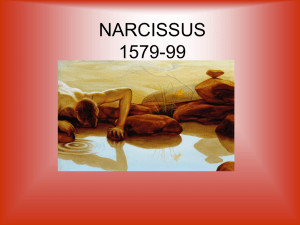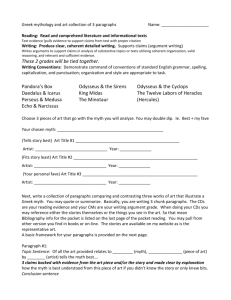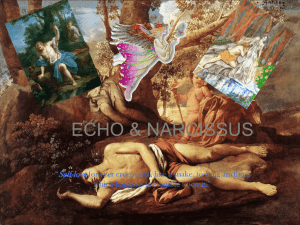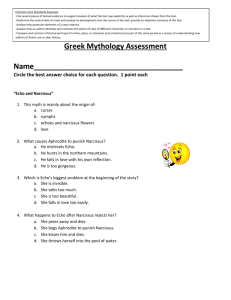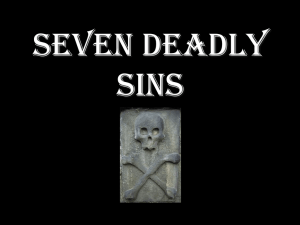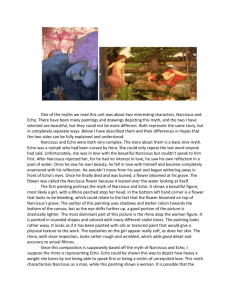The Myth of Narcissus in Surrealism and Poetry
advertisement
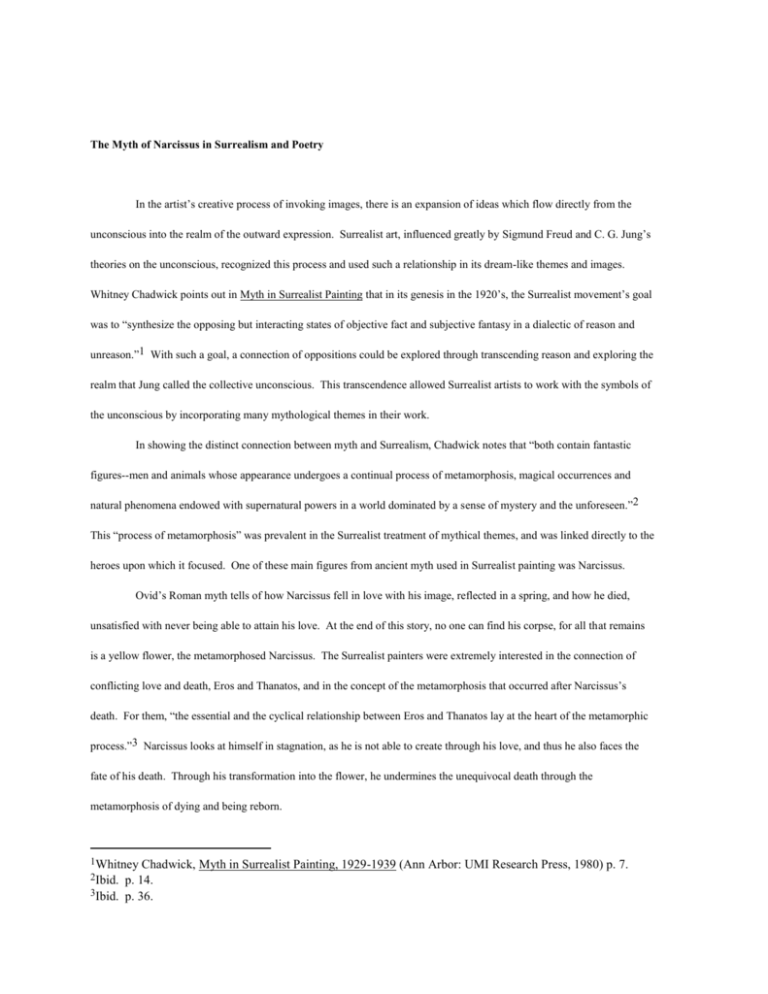
The Myth of Narcissus in Surrealism and Poetry In the artist’s creative process of invoking images, there is an expansion of ideas which flow directly from the unconscious into the realm of the outward expression. Surrealist art, influenced greatly by Sigmund Freud and C. G. Jung’s theories on the unconscious, recognized this process and used such a relationship in its dream-like themes and images. Whitney Chadwick points out in Myth in Surrealist Painting that in its genesis in the 1920’s, the Surrealist movement’s goal was to “synthesize the opposing but interacting states of objective fact and subjective fantasy in a dialectic of reason and unreason.”1 With such a goal, a connection of oppositions could be explored through transcending reason and exploring the realm that Jung called the collective unconscious. This transcendence allowed Surrealist artists to work with the symbols of the unconscious by incorporating many mythological themes in their work. In showing the distinct connection between myth and Surrealism, Chadwick notes that “both contain fantastic figures--men and animals whose appearance undergoes a continual process of metamorphosis, magical occurrences and natural phenomena endowed with supernatural powers in a world dominated by a sense of mystery and the unforeseen.”2 This “process of metamorphosis” was prevalent in the Surrealist treatment of mythical themes, and was linked directly to the heroes upon which it focused. One of these main figures from ancient myth used in Surrealist painting was Narcissus. Ovid’s Roman myth tells of how Narcissus fell in love with his image, reflected in a spring, and how he died, unsatisfied with never being able to attain his love. At the end of this story, no one can find his corpse, for all that remains is a yellow flower, the metamorphosed Narcissus. The Surrealist painters were extremely interested in the connection of conflicting love and death, Eros and Thanatos, and in the concept of the metamorphosis that occurred after Narcissus’s death. For them, “the essential and the cyclical relationship between Eros and Thanatos lay at the heart of the metamorphic process.”3 Narcissus looks at himself in stagnation, as he is not able to create through his love, and thus he also faces the fate of his death. Through his transformation into the flower, he undermines the unequivocal death through the metamorphosis of dying and being reborn. 1Whitney Chadwick, Myth in Surrealist Painting, 1929-1939 (Ann Arbor: UMI Research Press, 1980) p. 7. p. 14. 3Ibid. p. 36. 2Ibid. In Andre Masson’s painting, Narcissus of 1934, this idea of metamorphosis emerges through the hero who is hanging on the brink of his death. Narcissus’s body is portrayed half on the shore, facing upward, while the other half is turned downward towards the water: Salvador Dali’s approach to the myth shows the process of the metamorphosis even more clearly in Metamorphosis of Narcissus of 1936-7, in which the hunched figure of Narcissus appears next to a figure, similar in form, of a hand holding an egg from which a flower emerges. The woe of Narcissus’s love becomes a product of potential and creation in the symbol of the egg, and a new life in the blooming flower: In this whole dialectic relation of the metamorphosis through the conflict of Eros and Thanatos, Chadwick notes that the myth is “capable of being transformed into specifically surrealist statements about the relationship between man and the natural world.”4 In another realm of art, that being poetry, the images of the mythical also become resonating presences which express the artist’s feeling of the unconscious. In Ancient Myth in Modern Poetry, Lillian Feder explains how poets “rely on the characteristics of myth that insure such revelation: the conflict...between frailty and superhuman longings; and thus, the continual recurrence of struggle and at least partial resolution, the drive toward conquest or metamorphosis, destruction and renewal.”5 Here again the Eros, Thanatos, and metamorphosis themes are emphasized in the poetic treatment of myth. In poetry, conscious life can be transcended as the different layers of feeling and revelation are focused upon through the archetypal images of the collective unconscious. Jung, in Man and his Symbols, described an archetype as “a tendency to form such representations of a motif--representations that can vary a great deal in detail without losing their basic pattern.”6 Thus, the mythical character of Narcissus who reoccurs often in poetry in various different forms, can be considered an archetype. In “Narcissus,” by George Barker, the archetypal character is brought into a modern context, but still undergoes similar thematic changes as he does in the mythical story: My tired lips received that morning Their first kiss, so stirred the mind Cannot subside for days for weeks or months. That slim mouth upon mine held firm complete pressure, Keeping mine for the inconceivable period Between meeting in dream and meeting the unknown person. Therefore for days or months I examined all faces That slip between me and the exit to forget; At political meetings at parties and at festivals Every unrecognizing face, the features of every unrecognized face, refused To be that face, assumed adverse reaction, Closed its cold eyes on the air, and was removed. Traveling though a fine evening in a car The attentive line of my own face was at intervals caught From the sunlight in outline--the chin’s framed curve, Lips, jaws asseveration--on the windscreen; The reproduction on, the reality through 4Ibid. p. 104. Feder, Ancient Myth in Modern Poetry (Princeton: Princeton University Press, 1971) p. 344. 6Carl G. Jung, Man and his Symbols (New York: Dell Publishing, 1964) p. 58. 5Lillian I now no longer wander wondering who.7 This poem reflects the utter agony that Narcissus went through in not being able to be with the one that he loved, and at the end of the poem, the separation’s origin becomes clear when he learns that he longs for himself, and can stop wandering, wondering. Barker’s vision of this archetype is different in his “Holy Poems,” where Narcissus is in a state where bliss, loss and death are all intertwined: Narcissus, embalmed in glass and rivers, Speaks to me with the lisp of the tides; Murmurs to me late in the summer evenings When he goes down with the last fish, whispers: ’The kiss of doom is death. So deep a kiss, No love knows as the hermaphrodite worm: With it I lie always at the sex of bliss, And this is loss.’8 Feder comments that “Barker envisions Eros as separable from ‘the heart of the lover,’ and therefore from Thanatos, only when it is freed from individual man’s narcissism, possibly only by death itself.” 9 In May Sarton’s poem, “Narcissus,” the theme of death as the result of self-obsession is prevalent. Narcissus’s incarnation in this poem is a lonely figure, trapped and doomed. It is not love that he holds for himself in this case, however, but a fascination with the selves that he doesn’t know, but wants to tame: His eyes are darker than he knows. They flash out from a fire so deep It draws him down to burning shadows. It draws him further down than sleep. And there in any quiet room He faces a peculiar doom. Within the mirror’s empty face His own eyes dreadfully expose His solitary self, that place He cannot leave, he cannot reach. Whatever mirrors have to teach He will learn now before he moves, Lost in himself, but far from love. It is not love that makes him fall Deep into perilous reflection, Not love that holds him there at all, But rather something glimpsed and gone, Angels and unicorns he sees Vanish among the little trees, Their lives so innocent and wise That draw him into his own eyes, Those fleeting selves that come quite near 7George Barker, Collected Poems, 1930-1965 (New York: October House, 1965) 8Ibid. 9Feder, p. 382. But never tell him who they are. He knows that he can never leave Without the gift they have to give, Powers that he must catch and tame Or, drawn into the mirror, drown.10 W. H. Auden deals with the connection of death and love in his poem, “Death’s Echo.” In this poem, the reflection of Narcissus calls to him, like an alluring and deadly Siren: ‘O stretch your hands across the sea,’ The impassioned lover cries, ‘Stretch them towards your harm and me. Our grass is green, and sensual our brief bed, The stream sings at its foot, and at its head The mild and vegetarian beasts are fed.’ So the impassioned lover cries Till the storm of pleasure dies: From the bedpost and the rocks Death’s enticing echo mocks, And his voice replies, The greater the love, the more false to its object, Not to be born is the best for man; After the kiss comes the impulse to throttle, Break the embraces, dance while you can.11 Conrad Aiken’s Narcissus in “Preludes for Memnon” mocks the thought of death ever ruining his magnificent beauty, until it comes to him through his reflection: But then a wonder Deepened his gazing eyes, darkened the pupils, Shaded his face, as if a cloud had passed. The mirror spoke the truth. A shape he saw Unknown before,--obscene, disastrous, huge,-Huge as the world, and formless..Was this he? This dumb, tumultuous, all-including horror? * * * * * He pondered the vast vision: Saw mad order, the inhuman god; And his poor pity, with the mirror dropped, Wore a new face: such brightness and such darkness, Pitiless, as a moonblanched desert wears.12 Thus Narcissus becomes aware, as if losing all innocence, of the chaotic universe and the horror within his own soul. The prevalence in modern thought of connecting metamorphosis, Eros and Thanatos with the myth of Narcissus has created an interpretation of this myth that is extremely profound. Bringing the meaning of such an ancient story into the context of Surrealist art and modern poetry has created a new language by which artists can use images that have a wide10May Sarton, Selected Poems of May Sarton (New York: W, W. Norton, 1978) H. Auden, Collected Poems (New York: Random House, 1976) 12Conrad Aiken, Selected Poems (New York: Oxford University Press, 1961) 11W. reaching significance. The myth of Narcissus has allowed artists to create new readings of its personal importance, and has opened up a rich realm of unconscious metaphor and vision. BIBLIOGRAPHY Aiken, Conrad. Selected Poems. New York: Oxford University Press, 1961. Auden, W. H. Collected Poems. New York: Random House, 1976. Barker, George. Collected Poems, 1930-1965. New York: October House, 1965. Chadwick, Whitney. Myth in Surrealist Painting, 1929-1939. Ann Arbor: UMI Research Press, 1980. Feder, Lillian. Ancient Myth in Modern Poetry. Princeton: Princeton University Press, 1971. Jung, Carl G. Man and his Symbols. New York: Dell Publishing, 1964. Sarton, May. Selected Poems of May Sarton. New York: W, W. Norton, 1978.
